| ||||||||||||||||
| ||||||||||||||||
| ||||||||||||||||
 |
|---|
Presidential elections were held in Peru on 7 May 1876. Mariano Ignacio Prado of the Civilista Party was elected with 96% of the vote.
| ||||||||||||||||
| ||||||||||||||||
| ||||||||||||||||
 |
|---|
Presidential elections were held in Peru on 7 May 1876. Mariano Ignacio Prado of the Civilista Party was elected with 96% of the vote.
Former army general and president Mariano Ignacio Prado, who had served as Secretary of Finance under outgoing president Manuel Pardo, started his election campaign in May 1875. [1]
The ruling Civilista Party initially nominated José Simeón Tejeda as its presidential candidate. However, Tejeda died shortly before the election campaign was due to begin. The party subsequently adopted Prado as its candidate in January 1876. [1]
Prado was opposed by another military figure, Lizardo Montero Flores, who ran as an independent candidate.
The elections were indirect, with the president elected by the same electoral college elected in October 1875 that elected the Congress. [1]
The elections were marked by violence. [1]
| Candidate | Party | Votes | % | |
|---|---|---|---|---|
| Mariano Ignacio Prado | Civilista Party | 3,418 | 96.17 | |
| Lizardo Montero Flores | Independent | 136 | 3.83 | |
| Total | 3,554 | 100.00 | ||
| Total votes | 3,606 | – | ||
| Registered voters/turnout | 5,376 | 67.08 | ||
| Source: ONPE, [2] Witt [3] | ||||
Prado survived a coup attempt in May 1877 but was removed from office by a successful coup in December 1879, when he was replaced by Nicolás de Piérola.

Presidential elections were held in the United States on November 7, 1876. Republican Governor Rutherford B. Hayes of Ohio very narrowly defeated Democrat Governor Samuel J. Tilden of New York. Following President Ulysses S. Grant's decision to retire after his second term, U.S. Representative James G. Blaine emerged as frontrunner for the Republican nomination; however, Blaine was unable to win a majority at the 1876 Republican National Convention, which settled on Hayes as a compromise candidate. The 1876 Democratic National Convention nominated Tilden on the second ballot.
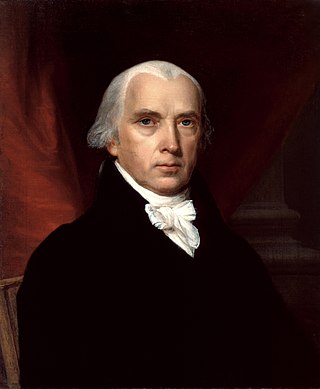
Presidential elections were held in the United States from October 30 to December 2, 1812. In the shadow of the War of 1812, incumbent Democratic-Republican President James Madison defeated DeWitt Clinton, the lieutenant governor of New York and mayor of New York City, who drew support from dissident Democratic-Republicans in the North as well as Federalists. It was the first presidential election to be held during a major war involving the United States.

Manuel González de Candamo e Iriarte served as the 33rd President of Peru from 1903 until his death in 1904. He also served as Interim President of Peru, officially as the President of the Government Junta, from September 8, 1903, until his death the following year.

Luis Mariano Ospina Pérez, commonly known as Mariano Ospina Pérez, was a Colombian politician and a member of the Colombian Conservative Party. He served as the 17th President of Colombia between 1946 and 1950.

Manuel Carlos Prado y Ugarteche was a Peruvian politician and banker who served twice as President of Peru. Son of former president Mariano Ignacio Prado, he was born in Lima and served as the nation's 43rd (1939–1945) and 46th (1956–1962) president. His brother, Leoncio Prado Gutiérrez, was a military hero who died in 1883, six years before Manuel Prado was born.
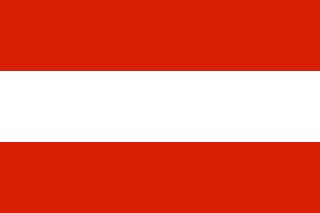
The Liberal Party of Honduras is a centrist liberal political party in Honduras that was founded in 1891. It is the oldest extant political party in the country; further, it is one of the two main parties that have, until recently, dominated Honduran politics. The party is a member of the Liberal International. The PLH is identified with the colours red and white, as the flag Francisco Morazán used in most of his military campaigns during time of the Central American Federal Republic.

Andrés Avelino Cáceres Dorregaray served as the President of Peru two times during the 19th century, from 1886 to 1890 as the 27th president, and again from 1894 to 1895 as the 30th. In Peru, he is considered a national hero for leading the resistance to Chilean occupation during the War of the Pacific (1879–1883), in which he fought as a general in the Peruvian Army.
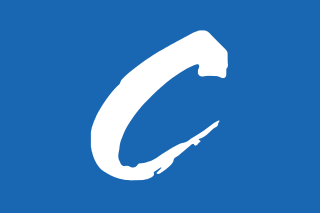
The Colombian Conservative Party is a conservative political party in Colombia. The party was formally established in 1849 by Mariano Ospina Rodríguez and José Eusebio Caro.
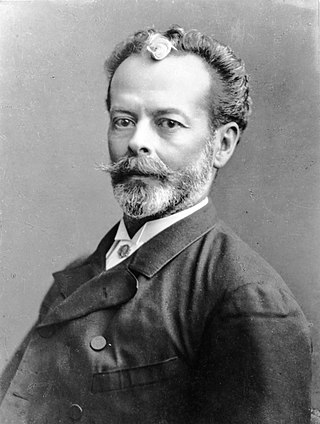
José Nicolás Baltasar Fernández de Piérola y Villena was a Peruvian politician and Minister of Finance who served as the 23rd and 31st President of the Republic of Peru, from 1879 to 1881 and 1895 to 1899.

Mariano Ignacio Prado Ochoa was a Peruvian army general who served as the 17th and 21st President of Peru.

José Balta y Montero was a Peruvian soldier and politician who served as the 19th President of Peru from 1868 to 1872. He was the son of John Balta Bru and Agustina Montero Casafranca.
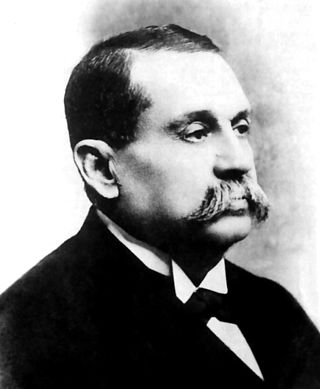
Guillermo Enrique Billinghurst Angulo was a Peruvian politician of English descent who served as the 37th President of Peru. He succeeded Augusto B. Leguía, from 1912 to 1914. An Anglo-Peruvian, Billinghurst's surname is a locational name; Billinghurst is a parish in Sussex, England.
Reformist Democratic Party was a political party in Peru. It was founded in 1920 by Augusto Bernardino Leguía y Salcedo, whose regime, which began the previous year, had led to a dictatorial government. It was a party with a strong personal character, whose members included the friends and relatives of President Leguía, as well as many public employees. It lacked an ideology and an authentic program and was only organized to support Leguía in the perpetuation of him in power. After the fall of Leguía in 1930, it did not again have a leading role in Peruvian politics and ended up dissolving.

José Simón Pardo y Barreda was a Peruvian politician who served as the 35th (1904–1908) and 39th (1915–1919) President of Peru.
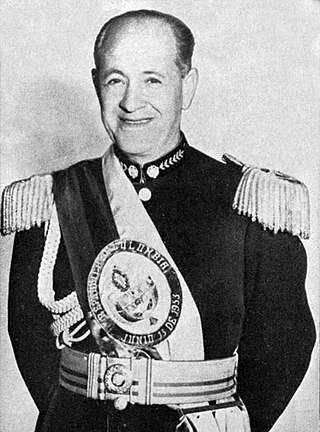
Gustavo Rojas Pinilla was a Colombian army general, civil engineer and politician who ruled as 19th President of Colombia in a military dictatorship from June 1953 to May 1957.
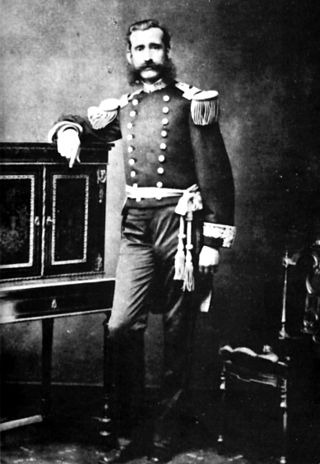
Juan Lizardo Montero Flores was a Peruvian military officer and politician who held the provisional Presidency of Peru from 1881 to 1883, replacing President Francisco García Calderón, during the Chilean occupation of Peru that took place as a result of the War of the Pacific. He was also Mayor of Lima for a brief period, in 1879. Montero was a friend and comrade-in-arms of Miguel Grau, Manuel Ferreyros and Aurelio García y García, all of whom were known as the "Four Aces of the Peruvian Navy".
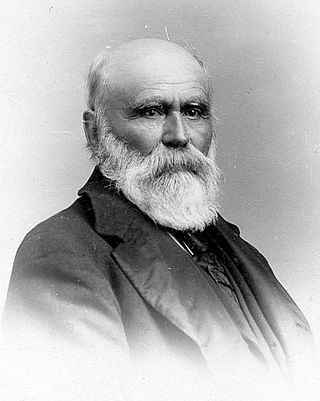
José Bonifacio Aquileo Elias Parra y Gómez de la Vega was a Colombian soldier, businessman and political figure. He was the President of Colombia between 1876 and 1878.

Tomás Francisco Gutiérrez Chávez was a Peruvian Colonel who, along with his brothers, led a coup against President José Balta Montero and served as the Supreme Leader of Peru for four days in July 1872. From July 22, 1872 to July 26, 1872, Gutiérrez was the de facto leader of Peru and the self-proclaimed "Supreme Leader of the Republic" after a coup d'état. He was overthrown just four days after his proclamation and lynched. Peru later regained some political stability with the election of Manuel Pardo, although this stability was short-lived as a foreign threat began to arise in Chile.

General elections were held in Costa Rica on 7 December 1913, the first direct elections since 1844. They were also the first elections to have universal male suffrage, after economic and educational requirements were eliminated. Máximo Fernández Alvarado of the Republican Party won the presidential election, but both he and runner-up Carlos Durán Cartín later resigned and Alfredo González Flores was appointed president by Congress on 8 May 1914. The Republican Party also won the parliamentary election.
Presidential elections were held in Peru in 1915. They followed a coup in January 1914 that overthrew the government of Guillermo Billinghurst.